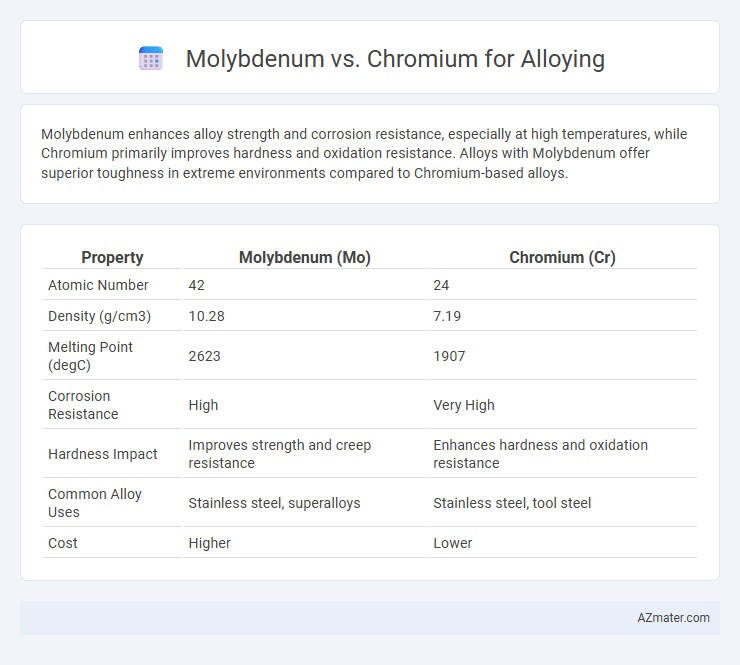Molybdenum enhances alloy strength and corrosion resistance, especially at high temperatures, while Chromium primarily improves hardness and oxidation resistance. Alloys with Molybdenum offer superior toughness in extreme environments compared to Chromium-based alloys.
Table of Comparison
| Property | Molybdenum (Mo) | Chromium (Cr) |
|---|---|---|
| Atomic Number | 42 | 24 |
| Density (g/cm3) | 10.28 | 7.19 |
| Melting Point (degC) | 2623 | 1907 |
| Corrosion Resistance | High | Very High |
| Hardness Impact | Improves strength and creep resistance | Enhances hardness and oxidation resistance |
| Common Alloy Uses | Stainless steel, superalloys | Stainless steel, tool steel |
| Cost | Higher | Lower |
Introduction to Alloying Elements: Molybdenum vs Chromium
Molybdenum and chromium are essential alloying elements that enhance steel's performance by improving strength, corrosion resistance, and hardness. Molybdenum increases high-temperature strength and resistance to wear and creep, making it ideal for industrial applications like power plants and aerospace. Chromium contributes significantly to corrosion and oxidation resistance, creating stainless steel alloys widely used in construction, automotive, and kitchenware industries.
Chemical Properties and Reactivity
Molybdenum exhibits superior corrosion resistance and oxidation stability at high temperatures compared to chromium, making it essential for enhancing alloy durability in extreme environments. Chromium provides excellent hardness and wear resistance through the formation of a stable oxide layer, crucial for stainless steel corrosion protection. The lower reactivity of molybdenum with acids and alkalis contrasts with chromium's higher chemical activity, influencing alloy choice based on operating conditions.
Role in Steel and Other Alloys
Molybdenum enhances steel's strength, hardness, and corrosion resistance by improving its high-temperature performance and toughness, making it essential in stainless and high-speed steels. Chromium primarily contributes to hardness, wear resistance, and corrosion protection by forming a stable oxide layer, crucial for stainless steel and tool alloys. Both elements are integral in alloying, with molybdenum favoring high-temperature applications and chromium providing enhanced surface durability and oxidation resistance.
Corrosion Resistance Comparison
Molybdenum significantly enhances corrosion resistance in alloys, especially against chloride-induced pitting and crevice corrosion, making it a preferred element in stainless steels used in marine and chemical environments. Chromium provides a fundamental corrosion-resistant oxide layer that protects alloys from oxidation and general corrosion but is less effective than molybdenum in aggressive, localized corrosion conditions. Alloys containing both molybdenum and chromium exhibit superior corrosion resistance, with molybdenum offering targeted protection in highly corrosive mediums while chromium ensures broad-spectrum durability.
Strength and Hardness Enhancement
Molybdenum significantly enhances alloy strength and hardness by promoting the formation of stable carbides and improving high-temperature creep resistance. Chromium increases hardness primarily through the formation of a hard, corrosion-resistant oxide layer and contributes to wear resistance and tensile strength. Alloys containing molybdenum generally exhibit superior strength retention at elevated temperatures compared to those alloyed with chromium.
Heat Resistance and High-Temperature Performance
Molybdenum exhibits superior heat resistance and maintains mechanical strength at temperatures above 1000degC, making it ideal for high-temperature alloy applications such as aerospace and power generation components. Chromium provides excellent oxidation resistance and contributes to the formation of a protective oxide layer, enhancing durability at elevated temperatures typically up to 900degC. Combining molybdenum with chromium in alloys results in a synergistic effect, improving both high-temperature strength and corrosion resistance under extreme thermal conditions.
Impact on Machinability and Workability
Molybdenum enhances alloy machinability by improving high-temperature strength and corrosion resistance, allowing for easier cutting and shaping of hardened steel components. Chromium contributes to better workability by increasing hardness and wear resistance, but it can reduce machinability due to the formation of hard carbides. Alloys with optimized molybdenum content often exhibit enhanced toughness and ductility, balancing machinability and workability for complex manufacturing processes.
Common Applications in Industry
Molybdenum is widely used in steel alloys to enhance strength, hardness, and corrosion resistance, making it essential for aerospace, automotive, and construction industries. Chromium is primarily utilized in stainless steel and plating industries due to its superior oxidation resistance and ability to improve hardness and wear resistance. Both elements are critical in high-temperature applications, but molybdenum excels in extreme pressure environments while chromium excels in corrosion-resistant coatings.
Cost and Availability Analysis
Molybdenum tends to be more expensive than chromium due to its scarcer geographic deposits and complex extraction processes, impacting overall alloy production costs. Chromium benefits from broader availability with large reserves, primarily in South Africa and Kazakhstan, which supports more stable pricing and supply chains for industrial alloying. Cost-efficiency in alloy selection often favors chromium alloys in mass production, while molybdenum is preferred for specialized applications requiring superior corrosion resistance and high-temperature strength despite its higher price.
Environmental and Health Considerations
Molybdenum and chromium are critical alloying elements with distinct environmental and health profiles; molybdenum poses lower toxicity risks and has a minimal environmental footprint compared to chromium, which can release hexavalent compounds linked to severe health hazards and environmental contamination. The mining and processing of chromium often generate hazardous waste requiring stringent controls to prevent soil and water pollution, whereas molybdenum extraction generally results in fewer toxic byproducts. Selecting molybdenum over chromium in alloys can reduce occupational exposure to carcinogenic substances and promote safer handling and disposal practices, aligning with sustainable manufacturing goals.

Infographic: Molybdenum vs Chromium for Alloying
 azmater.com
azmater.com